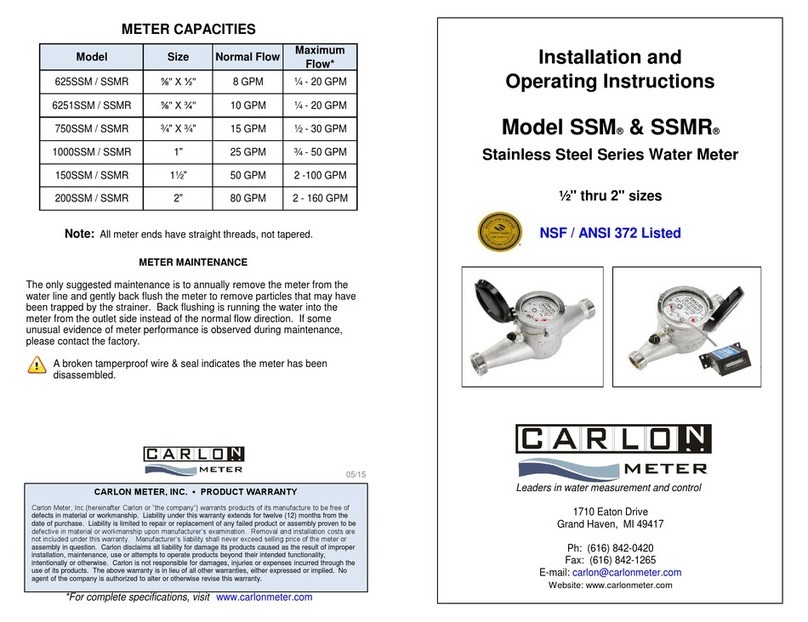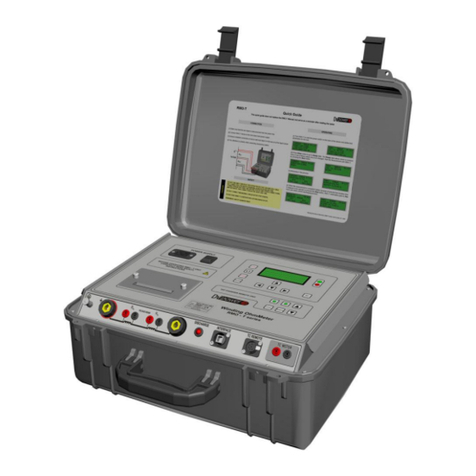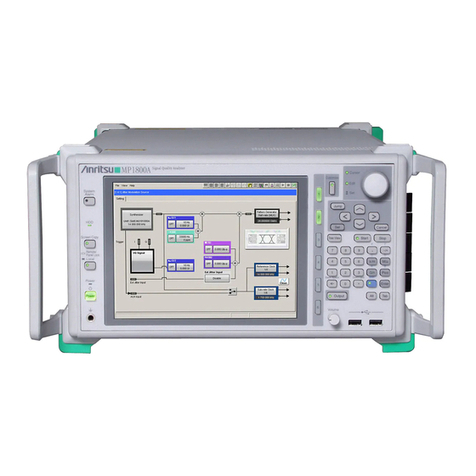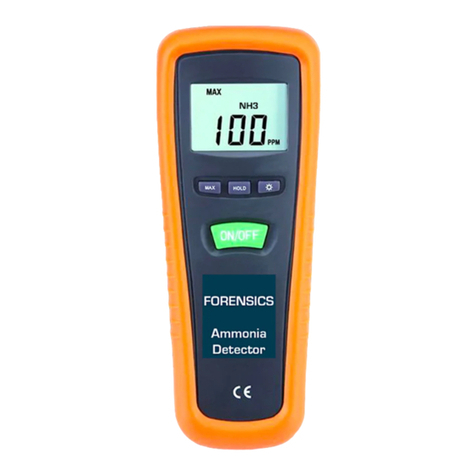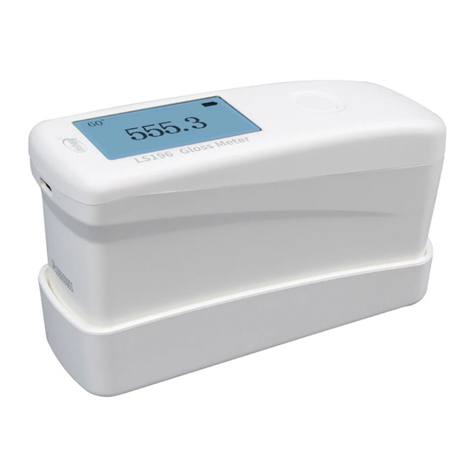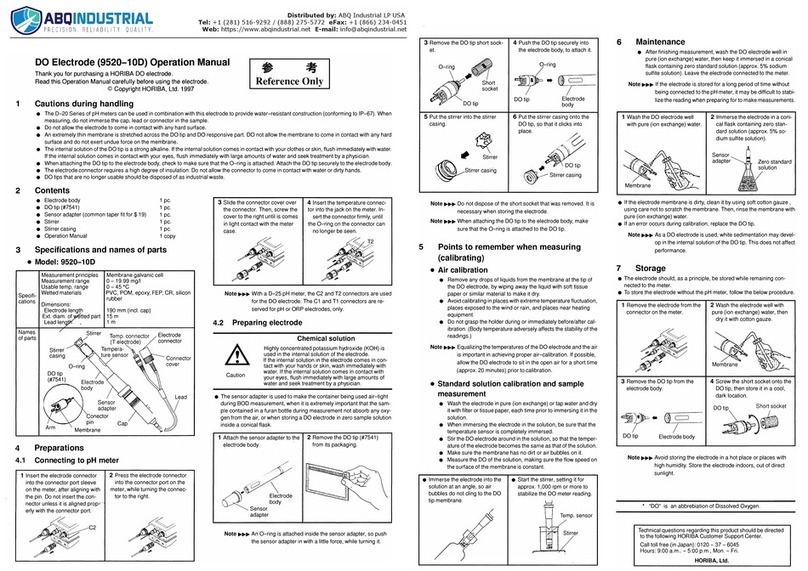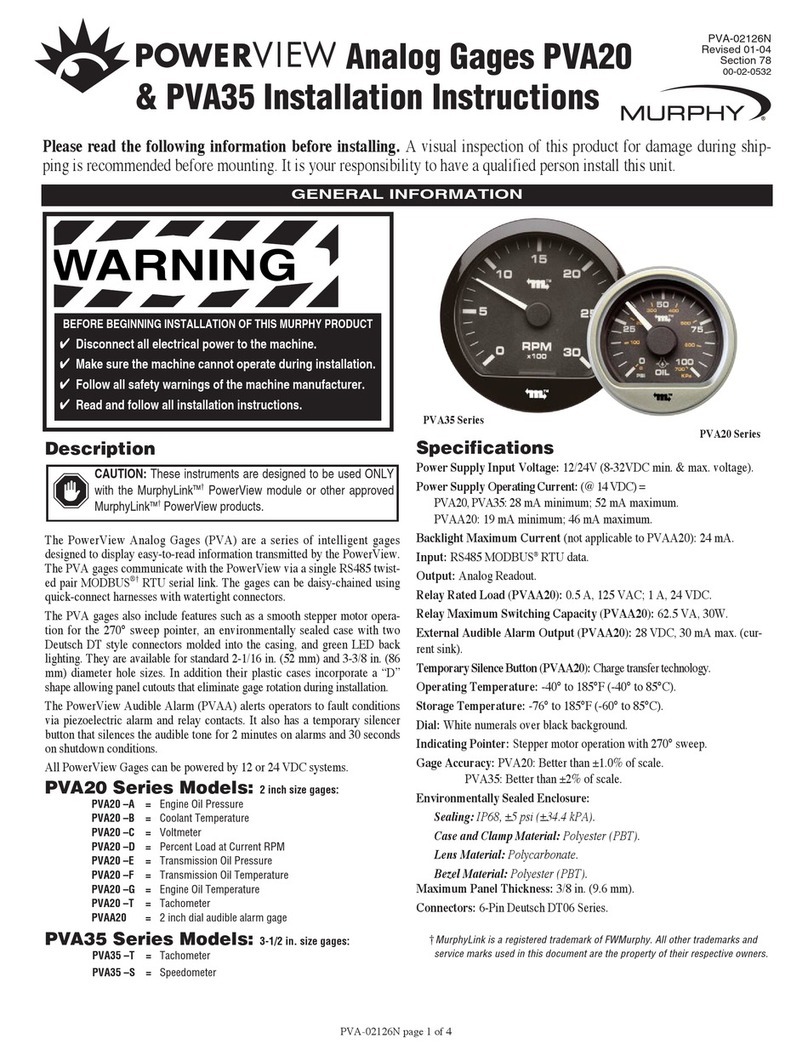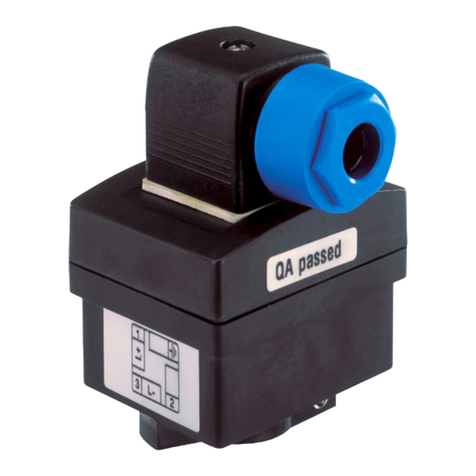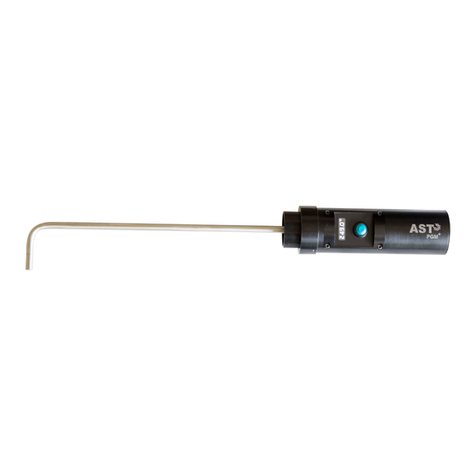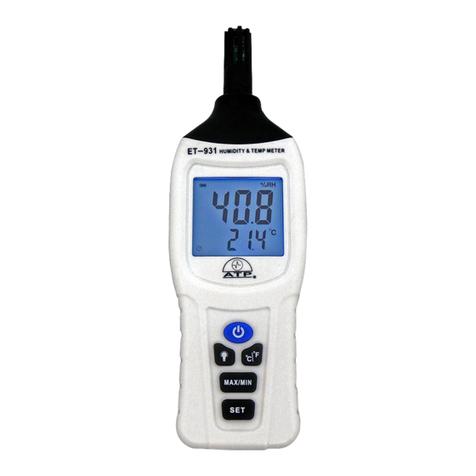CGEO INTERNATIONAL LIMITED CGEO-CR User manual

CGEO INTERNATIONAL LIMITED
Model CGEO-CR
Vibrating Wire Crackmeter
Installation Manual

TABLE of CONTENTS
1. INTRODUCTION .............................................................................................. 3
2. INSTALLATION ............................................................................................... 3
2.1. Preliminary Tests ........................................................................................ 3
2.2. Crackmeter Installation............................................................................... 4
2.2.1. Installation using Weldable Fixtures............................................ 4
2.2.2. Installation using Groutable Anchors .......................................... 5
2.2.3. Installation using Machine Bolt Expansion Anchors................... 6
2.3. Cable Installation ........................................................................................ 7
2.4. Electrical Noise........................................................................................... 7
2.5. Lightning Protection ................................................................................... 7
3. TAKING READINGS........................................................................................ 8
3.1. Operation of the CGEO-PR-VW Readout Box .......................................... 8
3.2. Measuring Temperatures............................................................................. 8
4. DATA REDUCTION ......................................................................................... 9
4.1. Deformation Calculation............................................................................. 9
4.2. Temperature Correction.............................................................................. 10
4.3. Environmental Factors................................................................................ 11
APPENDIX A - THERMISTOR TEMPERATURE DERIVATION ..................... 13

3
1. INTRODUCTION
Model CGEO-CR Vibrating Wire Crackmeters are designed to measure movement across joints
such as the construction joints in buildings, bridges, pipelines, dams, etc.;coordinating with other
different accessories, and also tension cracks in soils and joints in rock and concrete. The gauge is
often adopted surface-mounting manner.
The instrument consists of a vibrating wire sensing element in series with a heat treated, stress
relieved spring which is connected to the wire at one end and a connecting rod at the other. The
unit is fully sealed and operates at pressures of up to 1 Mpa (special requirements can be
customized). As the connecting rod is pulled out from the gage body, the spring is elongated
causing an increase in tension which is sensed by the vibrating wire element. The tension in the
wire is directly proportional to the extension, hence, the opening of the joint can be determined very
accurately by measuring the strain change with the vibrating wire readout box.
Ball Elbow Joint
Coil & thermistor Housing
Instrument Cable
Transducer Housing
Aligment Slot
Transducer Shaft
Ball Elbow Joint
Threaded Stud
Aligment Pin
Threaded Stud
Anhoring Rod
Figure 1 - Model CGEO-CR Vibrating Wire Crackmeter
CAUTION: Do not rotate the shaft of the Crackmeter. This may cause irreparable damage to
the instrument. The alignment pin on the transducer shaft and slot on the body serve as a guide
for alignment.
2. INSTALLATION
2.1. Preliminary Tests
Upon receipt of the instrument, the gage should be checked for proper operation (including the
thermistor). The Crackmeter normally arrives with it's shaft secured at approximately 50% of it's
range (see Figure 1). This holds the instrument in tension thereby helping protect it during shipping.

4
Connect the gage to the Readout to take a reading (see section 3). The reading should be stable and
in the range of 4000 to 5000.
Checks of electrical continuity can also be made using an ohmmeter. Resistance between the gage
leads should be approximately 180 ohms, ±10 ohms. Remember to add cable resistance when
checking (22 AWG stranded copper leads are approximately 14.7
/1000' or 48.5
/km, multiply by
2 for both directions). Between the green and white should be approximately 3000 ohms at 25°(see
Table B-1), and between any conductor and the shield should exceed 2 megohms.
2.2. Crackmeter Installation
CGEO-CR Model Surface Crackmeter can adopt welding fixture and anchoring manners. You can
first weld anchor rod directly on steel member, and then install transducer on anchor rod through
the bolts of elbow joint. Another is grouting anchor rod, it adopts a length of twisted-steel
connected with the elbow joint. Besides, the factory can also make special forms of installation
parts upon requirement.
75 mm
10mm
Thread
Figure 3 –Standard Grouting Anchor Rod
When setting the gage position using a portable readout (see section 3) use the ranges in Table 2 to
determine the proper position.
Mid-Range
Measure Extension
Measure Retraction
4500-5000
2500-3000
6500-7000
Table 2 - Crackmeter Reading Ranges
Note also that the calibration sheet supplied with the Crackmeter shows actual readings at zero,
25%, 50%, 75% and 100% of the range of extension. These readings can be used as a guide to set
the Crackmeter in any part of it's range, either in anticipation of closure or opening of the crack.
The Crackmeter can be extended until the desired reading (see Section 3 for readout instructions) is
obtained and then held in this position while the distance between the anchor points (threaded studs
on ball elbow joints, see Figure 1) is measured. This measurement can then serve as a guide for
drilling or welding the anchor points.
Caution: Do not rotate the shaft of the Crackmeter. This may cause irreparable damage to the
instrument. The alignment pin on the transducer shaft and slot on the body serve as a guide for
alignment.
2.2.1. Installation using Weldable Fixtures

5
Fissure
Weld
Weld
Weld
Weld
Weld Device
Weld Device
Elbow Joint
Fixed Bolt
Figure 4 - Installation using Weldable Fixtures
Installation instructions;
1. Determine proper setting distance using figures in Table 1 or the readings on the calibration
sheet. Prepare the surface (grinding, sanding, etc.) of the steel around the area of each
weldable fixture.
2. Locate fixtures on prepared surfaces, check spacing again and tack weld to member.
3. Remove the nylon tie securing the transducer shaft. Screw the ball stud on each end of the
crackmeter into the respective threaded holes on the fixtures. Remove the cotter pins from
the end of each ball elbow joint and tighten the ball using a regular blade screwdriver. Re-
install the cotter pins to secure the ball locking screw.
4. Check the reading with a portable readout. Use Table 2 or the readings on the calibration
sheet to check the position. Installation complete.
Note: Under normal circumstance, the installation of transducer itself should be after the welding of
weldable fixture, after completion of transducer installation, prohibited is any welding treatment of
weldable fixture, or it may cause transducer permanent damage.CGEO will not response for any
warranty and liability of any damage caused by this. Even if performing welding under protection
cover installation, you must do it in same end of transducer grounding, simultaneously avoid
intentionally or un-intentionally touching striking arc, that is, ensure welding current not through
transducer from beginning to end. You can consult the factory for the relevant manner.
2.2.2. Installation using Groutable Anchors
Groutable Anchor
Groutable Anchor
Grout or Epoxy
Grout or Epoxy
crack
Setting Distance
Figure 5 - Installation using Groutable Anchors

6
Installation instructions;
1. Determine proper setting distance using figures from Table 1 or the readings on the
calibration sheet. Using a hammer drill or other suitable equipment, drill two ½" holes
approximately 3" deep at the proper locations. Shorter holes may be drilled if the anchors
are cut down accordingly.
2. Assemble the Crackmeter with anchors attached. If installing the instrument at the mid-
range position, leave the nylon tie installed (see Figure 1) that secures the transducer shaft.
Fill the holes with grout or epoxy and push the anchors in until the tops are flush with the
surface. For holes drilled overhead use a quick setting grout or epoxy.
3. Secure the instrument after the grout or epoxy has set. Remove the cotter pins from the end
of each ball elbow joint and tighten the ball using a regular blade screwdriver. Re-install the
cotter pins to secure the ball locking screw. Remove the nylon tie.
4. Check the reading with a portable readout. Use Table 2 or the readings on the calibration
sheet to check the position. Installation complete.
2.2.3. Installation using Machine Bolt Expansion Anchors
The Bolt Expansion Anchor is needed to customize, applied to quick installation or unable to
install groutable anchor. The user self can also purchase inner expansion (inner explosion type)
bolt, make a M6 hole in bolt using for the connection of elbow joint.
Expansion Anchor
Expansion Anchor
Crack
Setting Distance
Figure 6 - Installation using Machine Bolt Expansion Anchors
Installation instructions;
1. Determine proper setting distance using figures from Table 1 or the readings on the
calibration sheet. Using a hammer drill or other suitable equipment, drill two ½" holes
approximately 2" deep at the proper locations.
2. Insert the expansion anchors with the threaded ends down into the hole, and tighten.
3. Remove the nylon tie securing the transducer shaft. Screw the ball stud on each end of the
crackmeter into the respective threaded holes in the anchors. Remove the cotter pins from
the end of each ball elbow joint and tighten the ball using a regular blade screwdriver. Re-
install the cotter pins to secure the ball locking screw.
4. Check the reading with a portable readout. Use Table 2 or the readings on the calibration
sheet to check the position. Installation completes.

7
2.3. Cable Installation
The cable should be routed in such a way so as to minimize the possibility of damage due to
moving equipment, debris or other causes.
Cables may be spliced to lengthen them, without affecting gage readings. Always waterproof the
splice completely, preferably using an epoxy based splice kit such the dedicated cable heat
shrinkable connector kit. These kits are available from the factory. quick cable connector also can
be used.
2.4. Electrical Noise
Care should be exercised when installing instrument cables to keep them as far away as possible
from sources of electrical interference such as power lines, generators, motors, transformers, arc
welders, etc. Cables should never be buried or run with AC power lines. The instrument cables
will pick up the 50 or 60 Hz (or other frequency) noise from the power cable and this will likely
cause a problem obtaining a stable reading. Contact the factory concerning filtering options
available for use with the CGEO dataloggers and readouts should difficulties arise.
2.5. Lightning Protection
The Vibrating Wire Crackmeter, unlike numerous other types of instrumentation available from
CGEO, do not have any integral lightning protection components, i.e. transzorbs or plasma surge
arrestors. Usually this is not a problem however, if the instrument cable is exposed, it may be
appropriate to install lightning protection components, as the transient could travel down the cable
to the gage and possibly destroy it.
Note the following suggestions;
If the gage is connected to a terminal box or multiplexer components such as plasma surge
arrestors (spark gaps) may be installed in the terminal box/multiplexer to provide a measure of
transient protection. Terminal boxes and multiplexers available from CGEO provide locations
for installation of these components.
Lighting arrestor boards and enclosures are available from CGEO that install near the
instrument. The enclosure has a removable top so, in the event the protection board (LAB-3) is
damaged, the user may service the components (or replace the board). A connection is made
between this enclosure and earth ground to facilitate the passing of transients away from the
gage. See Figure 7. Consult the factory for additional information on these or alternate
lightning protection schemes.

8
Figure 7 - Lightning Protection Scheme
3. TAKING READINGS
The following three sections describe how to take readings using one of readouts available from
CGEO.
3.1. Operation of the CGEO-PR-VW Readout Box
CGEO-PR-VW can be used for Surface Crackmeter measurement. Connect the Readout using the
flying leads or in the case of a terminal station, with a connector. The red and black clips are for the
vibrating wire gage, the white and green clips are for the thermistor and the blue for the shield drain
wire.
1. Turn the display selector to position "B" . Readout is in digits.
2. Turn the unit on and a reading will appear in the front display window. The last digit may
change one or two digits while reading. Record the value displayed. If no reading displays
or the reading is unstable see section 5 for troubleshooting suggestions. The thermistor will
be read and output directly in degrees centigrade.
3. The unit will automatically turn itself off after approximately 15 minutes to conserve power.
Details please see the CGEO-PR-VW Instruction Manual.
3.2. Measuring Temperatures
Each Vibrating Wire Crackmeter is equipped with a thermistor for reading temperature. The
thermistor gives a varying resistance output as the temperature changes. Usually the white and
green leads are connected to the internal thermistor.

9
1. Connect an ohmmeter to the two thermistor leads coming from the Crackmeter. (Since the
resistance changes with temperature are so large, the effect of cable resistance is usually
insignificant.)
2. Look up the temperature for the measured resistance in Table B-1. Alternately the
temperature could be calculated using Equation B-1.
Note: The CGEO-PR-VW readout box will read the thermistor and display temperature in
C
automatically.
4. DATA REDUCTION
4.1. Deformation Calculation
The basic units utilized by CGEO for measurement and reduction of data from Vibrating Wire
Crackmeters are "digits". Calculation of digits is based on the following equation;
Digits Hz
2
1000
Equation 1 - Digits Calculation
To convert digits to deformation the following equation applies;
Duncorrected = (R1- R0)
G
Equation 2 - Deformation Calculation
Where; R1is the current reading.
R0is the initial reading, usually obtained at installation
G is the calibration factor, unit as mm/digit, given in calibration sheet.
For example, the initial reading R0, at installation of a crackmeter is 2500 digits. The current
reading, R1, is 6000. The calibration factor is 0.00356 mm/digit. The deformation change is;
Duncorrected = (6000
2500)
0.00356 = +12.446 mm
Note that increasing readings (digits) indicate increasing extension.
When the environment temperature changes big( over 10℃), it needs temperature correction and it
is performed according to calculation formula supplied in the factory calibration sheet. Please see
table 8 and next chapter.
VIBRATING WIRE INSTRUMENT CALIBRATION CERTIFICATE
Model:CGEO-CR-50T
Serial Number:
081802

10
Temperature:20 ℃
Humidity:
32%RH
Testing Result
Range:(0---50)mm
Reader box: CGEO-PR-VW
Applied
Gage
Reading
1st Cycle
Gage
Reading
2nd Cycle
Gage
Reading
3rd Cycle
Average
Gage
Reading
Error
Error
Displacement
Linear
Polynomial
(mm)
(F.S)
(F.S)
0.0
2441.8
2440.6
2441.5
2441.3
-0.20%
-0.01%
10.0
3479.3
3479.7
3479.0
3479.3
0.06%
0.02%
20.0
4509.8
4508.1
4509.5
4509.1
0.16%
0.01%
30.0
5533.0
5532.3
5532.7
5532.7
0.13%
-0.02%
40.0
6552.0
6551.7
6551.9
6551.9
0.03%
-0.01%
50.0
7566.4
7566.3
7566.1
7566.3
-0.18%
0.01%
/
/
/
/
/
/
/
Calculated Displacement:
Linear,L(mm) = G (R1-R0) + K (T1-T0)
Polynomial,L(mm) = AR12+ BR1+ C + K (T1-T0)
Linear Gage Factor :G =
0.00975839
mm/Digit
(mm) Polynomial Gage Factors:A =
0.000000026645441378193
B =
0.0094917094213891
C =
-23.33732890100
Thermal Factor:K =
0.00853859
mm/℃
R0……….Original Reading
T0……….Original Tempera
Hereinafter Blank
Figure 8 - Typical Crackmeter Calibration Sheet
4.2. Temperature Correction
The Model CGEO-CR Vibrating Wire Crackmeters have a very small coefficient of thermal
expansion so in many cases correction is not necessary. However, if maximum accuracy is desired
or the temperature changes are extreme (>10°C) corrections may be applied. The temperature
coefficient of the mass or member to which the Crackmeter is attached should also be taken into
account. By correcting the transducer for temperature changes the temperature coefficient of the
mass or member may be distinguished. The following equation applies;
Dcorrected = (R1- R0)
G + ((T1- T0)
K

11
Equation 3 - Thermally Corrected Deformation Calculation
Where; R1is the current reading.
R0is the initial reading.
G is the calibration factor.
T1is the current temperature.
T0is the initial temperature.
K is the thermal coefficient (see calibration sheet).
Consider the following example using a Model J2-25 mm Crackmeter;
R0= 4773 digits
R1= 4589 digits
T0= 20.3°C
T1= 32.9°C
G= 0.00555 mm/digit
K = (((4589
0.000301) + 0.911)
0.00555 ) = 0.0127
Dcorrected = ((R1- R0)
C) + (((T1- T0)
K)
Dcorrected = ((4589 - 4773)
0.00555) + ((32.9 - 20.3)
0.0127)
Dcorrected = (-184
0.00555) + 0.160
Dcorrected = -1.021 + 0.160
Dcorrected = -0.861 mm
As can be seen from the above example, the corrections for temperature change are very small and
can usually be ignored.
4.3. Environmental Factors
Since the purpose of the crackmeter installation is to monitor site conditions, factors which may
affect these conditions should always be observed and recorded. Seemingly minor effects may have
a real influence on the behavior of the structure being monitored and may give an early indication
of potential problems. Some of these factors include, but are not limited to: blasting, rainfall, tidal
levels, excavation and fill levels and sequences, traffic, temperature and barometric changes,
changes in personnel, nearby construction activities, seasonal changes, etc.
5. TROUBLESHOOTING
Maintenance and troubleshooting of CGEO Vibrating Wire Crackmeters is confined to periodic
checks of cable connections and maintenance of terminals. The transducers themselves are sealed
and cannot be opened for inspection. However, note the following problems and possible solutions
should difficulties arise. Consult the factory for additional troubleshooting help.
Symptom: Crackmeter Readings are Unstable
Is the readout box position set correctly? If using a datalogger to record readings automatically
are the swept frequency excitation settings correct?

12
Is the transducer shaft positioned outside the specified range (either extension or retraction) of
the instrument? Note that when the transducer shaft is fully retracted with the alignment pin
inside the alignment slot (Figure 1) the readings will likely be unstable because the vibrating
wire is now under-tensioned.
Is there a source of electrical noise nearby? Most probable sources of electrical noise are
motors, generators and antennas.
Symptom: Crackmeter Fails to Read
Is the cable cut or crushed? This can be checked with an ohmmeter. Nominal resistance
between the two transducer leads (usually red and black leads) is 180
,
10
. Remember to
add cable resistance when checking (22 AWG stranded copper leads are approximately 14.7
/1000' or 48.5
/km). If the resistance reads infinite, or very high (>1 megohm), a cut wire must
be suspected. If the resistance reads very low (
100
) a short in the cable is likely. Splicing
kits and instructions are available from the factory to repair broken or shorted cables. Consult
the factory for additional information.
Does the readout or datalogger work with another transducer? If not the readout or datalogger
may be malfunctioning.

13
APPENDIX A - THERMISTOR TEMPERATURE DERIVATION
Thermistor Type: YSI 44005, Dale #1C3001-B3, Alpha #13A3001-B3
Resistance to Temperature Equation:
TA B LnR C LnR
12732
3
( ) ( ) .
Equation B-1 Convert Thermistor Resistance to Temperature
Where: T
Temperature in
C.
LnR
Natural Log of Thermistor Resistance
A
1.4051
10-3 (coefficients calculated over the
50 to +150
C. span)
B
2.369
10-4
C
1.019
10-7
Ohms
Temp
Ohms
Temp
Ohms
Temp
Ohms
Temp
Ohms
Temp
201.1K
-50
16.60K
-10
2417
30
525.4
70
153.2
110
187.3K
-49
15.72K
-9
2317
31
507.8
71
149.0
111
174.5K
-48
14.90K
-8
2221
32
490.9
72
145.0
112
162.7K
-47
14.12K
-7
2130
33
474.7
73
141.1
113
151.7K
-46
13.39K
-6
2042
34
459.0
74
137.2
114
141.6K
-45
12.70K
-5
1959
35
444.0
75
133.6
115
132.2K
-44
12.05K
-4
1880
36
429.5
76
130.0
116
123.5K
-43
11.44K
-3
1805
37
415.6
77
126.5
117
115.4K
-42
10.86K
-2
1733
38
402.2
78
123.2
118
107.9K
-41
10.31K
-1
1664
39
389.3
79
119.9
119
101.0K
-40
9796
0
1598
40
376.9
80
116.8
120
94.48K
-39
9310
1
1535
41
364.9
81
113.8
121
88.46K
-38
8851
2
1475
42
353.4
82
110.8
122
82.87K
-37
8417
3
1418
43
342.2
83
107.9
123
77.66K
-36
8006
4
1363
44
331.5
84
105.2
124
72.81K
-35
7618
5
1310
45
321.2
85
102.5
125
68.30K
-34
7252
6
1260
46
311.3
86
99.9
126
64.09K
-33
6905
7
1212
47
301.7
87
97.3
127
60.17K
-32
6576
8
1167
48
292.4
88
94.9
128
56.51K
-31
6265
9
1123
49
283.5
89
92.5
129
53.10K
-30
5971
10
1081
50
274.9
90
90.2
130
49.91K
-29
5692
11
1040
51
266.6
91
87.9
131
46.94K
-28
5427
12
1002
52
258.6
92
85.7
132
44.16K
-27
5177
13
965.0
53
250.9
93
83.6
133
41.56K
-26
4939
14
929.6
54
243.4
94
81.6
134
39.13K
-25
4714
15
895.8
55
236.2
95
79.6
135
36.86K
-24
4500
16
863.3
56
229.3
96
77.6
136
34.73K
-23
4297
17
832.2
57
222.6
97
75.8
137
32.74K
-22
4105
18
802.3
58
216.1
98
73.9
138
30.87K
-21
3922
19
773.7
59
209.8
99
72.2
139
29.13K
-20
3748
20
746.3
60
203.8
100
70.4
140
27.49K
-19
3583
21
719.9
61
197.9
101
68.8
141
25.95K
-18
3426
22
694.7
62
192.2
102
67.1
142
24.51K
-17
3277
23
670.4
63
186.8
103
65.5
143
23.16K
-16
3135
24
647.1
64
181.5
104
64.0
144
21.89K
-15
3000
25
624.7
65
176.4
105
62.5
145
20.70K
-14
2872
26
603.3
66
171.4
106
61.1
146
19.58K
-13
2750
27
582.6
67
166.7
107
59.6
147
18.52K
-12
2633
28
562.8
68
162.0
108
58.3
148
17.53K
-11
2523
29
543.7
69
157.6
109
56.8
149
55.6
150
Table A-1 Thermistor Resistance versus Temperature
Table of contents
Other CGEO INTERNATIONAL LIMITED Measuring Instrument manuals
Popular Measuring Instrument manuals by other brands
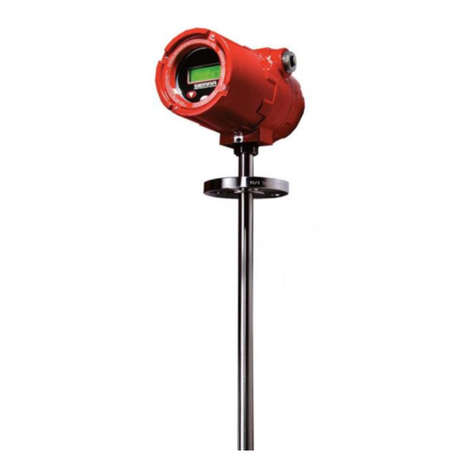
Sierra
Sierra Profibus DP 600 Series instruction manual
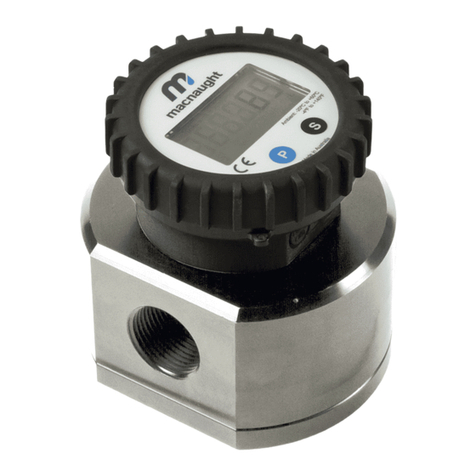
Macnaught
Macnaught MX06S instruction manual
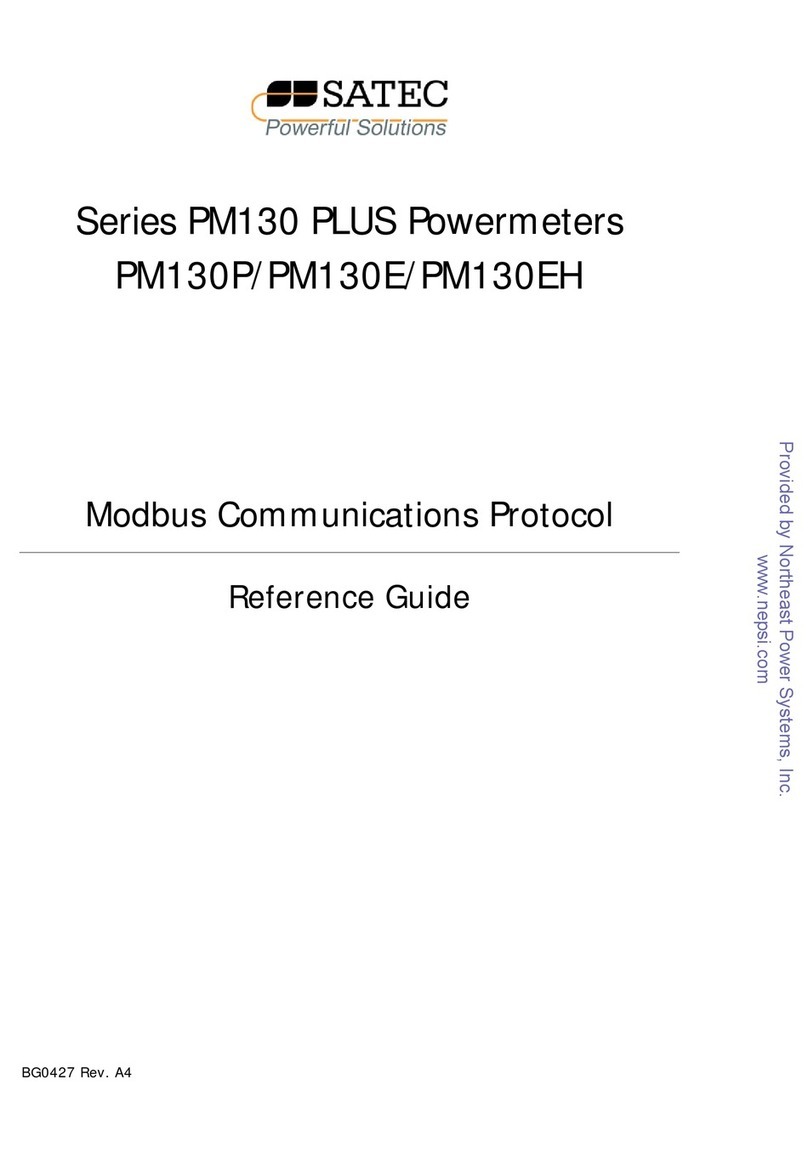
Satechi
Satechi pm130p reference guide
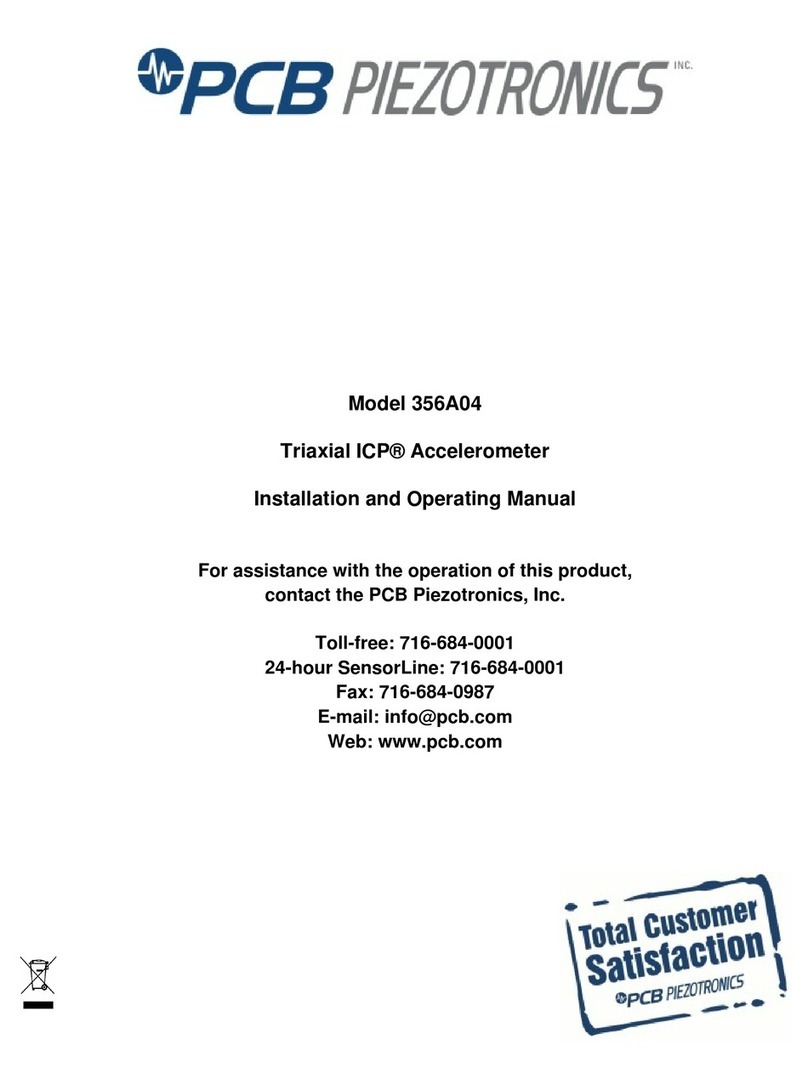
PCB Piezotronics
PCB Piezotronics ICP 356A04 Installation and operating manual
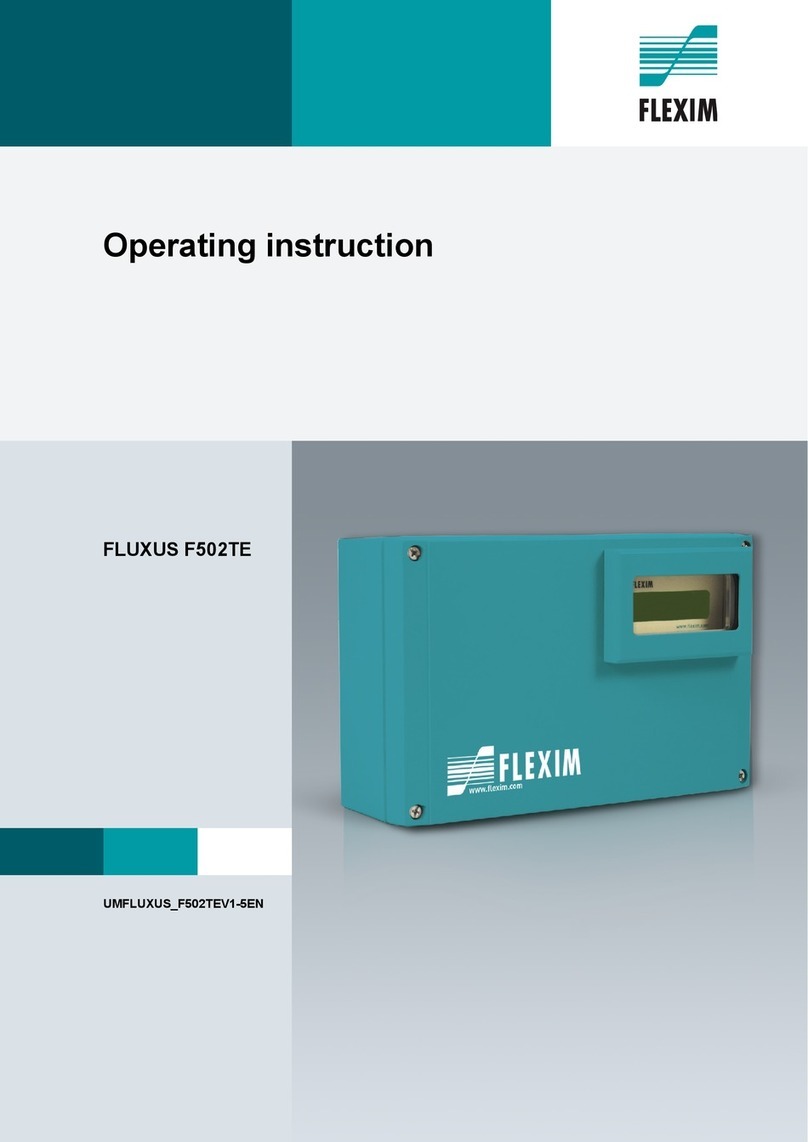
Flexim
Flexim FLUXUS F502TE Operating instruction
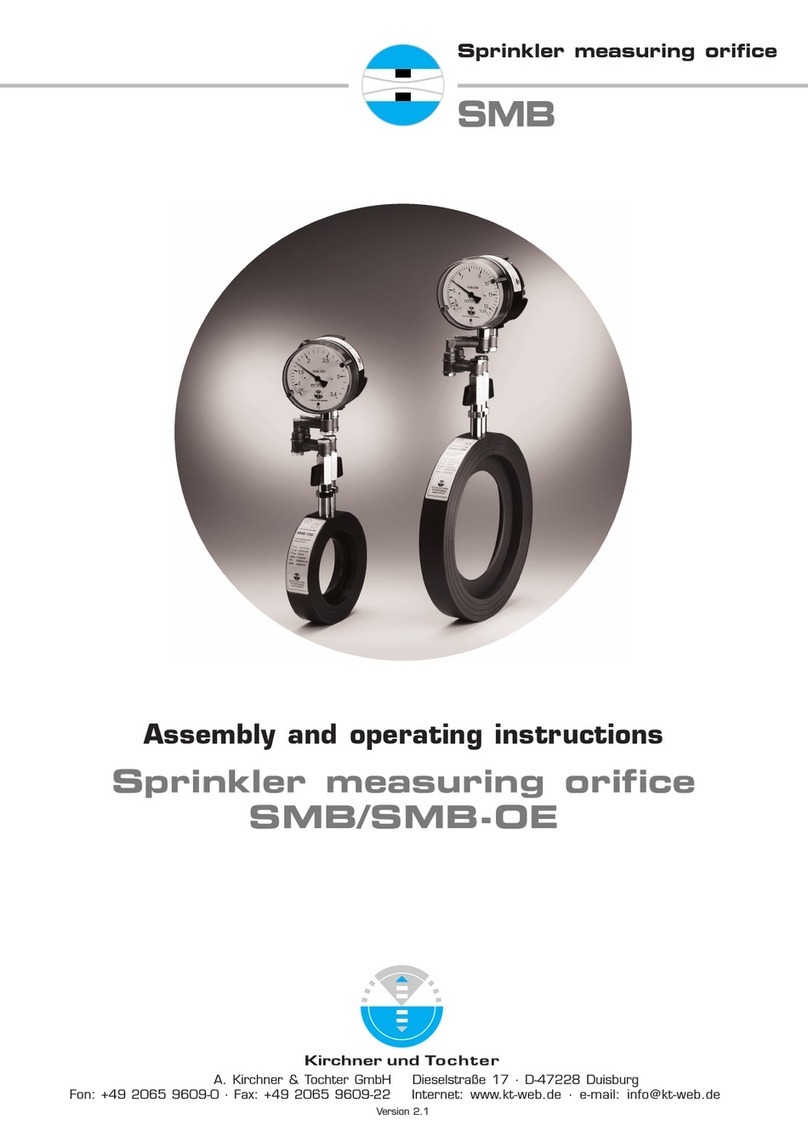
Kirchner und Tochter
Kirchner und Tochter SMB Series Assembly and operating instructions


